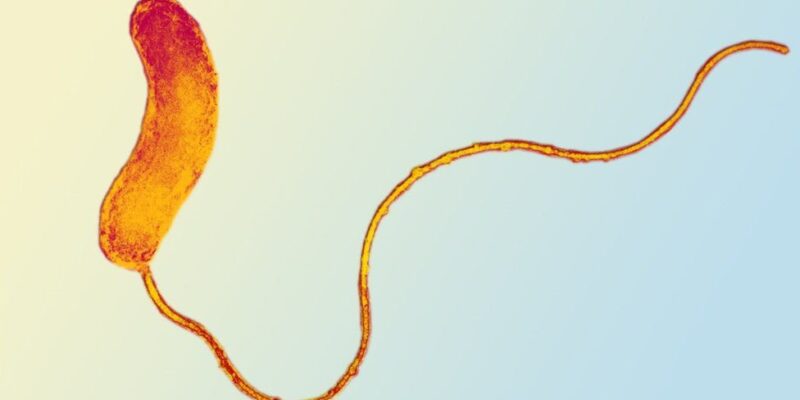– Dr. Deepika
Abstract
Antibiotics are responsible for the sharp decline of infectious disease-related deaths caused by bacteria over the past 50 years. However, due to the overuse and misuse of antibiotics, the rise of multidrug-resistant (MDR) bacterial infections have posed a serious threat to general public health. The Center for Disease Control (CDC) estimated that over 2 million people were infected and more than 23,000 died annually in the USA as a direct result of an MDR infection. This situation may worsen in the near future.
The World Health Organization (WHO) estimated that antibiotics add 20 years to each person's life. However, the overuse of antibiotics puts pressure on bacteria to evolve resistance against these drugs, leading to the emergence of untreatable superbugs. Researchers of South Korea's Ulsan National Institute of Science and Technology (UNIST) are aiming to launch predatory bacteria capable of attacking other bacteria without harming human cells i.e "Bacteria eating bacteria.”
The antimicrobial resistance (AMR) dilemma shows no sign of diminishing and may hamper the healthcare systems in the future as bacteria has shown resistance towards the aminoglycoside, penicillin, quinolone, sulfonamide and tetracycline classes of antibiotics which are mainly employed to amend common bacterial infections (Zaman et al. 2017). In the midst of this global crisis, a potential discovery of Bdellovibrio and other members resulted in the birth of a new research in identifying their potential value in clinical settings with particular interest being placed in exploiting them as living antibiotics‛ (Dwidar et al., 2012; Gupta et al., 2016).
Keywords • Antibiotics • Antimicrobial resistance • Bdellovibrio bacteriovorus • Predatory bacteria
Introduction
Professor Robert Mitchell is developing a natural compound called violacein to tackle Staphylococcus, a group of around 30 different bacteria known to cause skin infections, pneumonia and blood poisoning. Some Staphylococcus bacteria such as MRSA (methicillin- resistant Staphylococcus aureus) are resistant to antibiotics, making infections harder to treat.

Violacein known 'bisindole': a metabolite produced by bacteria from the condensation of two molecules of tryptophan (an essential amino acid used in many organisms to ensure normal functioning, avoid illness and death). Bisindole is vibrant purple and an area of interest to researchers for its anticancer, antifungal and antiviral properties.Researchers have discovered that it can stop the bacteria from reproducing, killing the multidrug resistant bacterium Staphylococcus aureus.
The team is now collaborating with fabric manufacturer Yeejoo Co., the Korea Institute of Ceramic Engineering and Technology, and research teams in Turkey and Romania to manufacture antibacterial fabrics infused with violacein that can effectively kill S. aureus.
The prime candidate predatory bacterium is known as “Bdellovibrio bacteriovorus”. It is a gram negative Deltaproteobacterium that expresses a single polar flagellum that renders it as one of the fastest moving organisms in nature found in soils and water globally. B. bacteriovorus are free-living, harmless obligate predator of bacteria-harmless to humans. They are the group that includes Salmonella, Escherichia coli, and several other pathogens.
How does Bdellovibrio bacteriovorus work?
Bdellovibrio punches a hole in the membranes of their prey, then enters and consumes their contents, then bursts out again to search for their next meal. The entire process is both quick and efficient, as it only takes 2–3 hours for a single prey cell to be completely digested.
“So basically B. bacteriovorus are very efficient killing machines”, as said by Daniel Kadouri, an associate professor at the Rutgers School of Dental Medicine in Newark, New Jersey.
Researchers are evaluating Bdellovibrio and other similar predatory bacteria as a route to treating intractable,antibiotic-resistant infections.


Enemy of Bdellovibrio: Indole
The researchers examined the predatory ability of B. bacteriovorus which was affected by indole, a metabolite produced by E. coli and many other bacteria. E. coli is a common bacterial strain that can cause food poisoning, infections and fever. Indole regulates various biological functions in bacteria, for example regulating the stability of small DNA molecules, as well as functioning as a signalling molecule, which different communities of bacteria use to 'talk' and coordinate gene expression within a population.
The researchers made a setup of bacterial version of a gladiator contest in the flasks. They put various bacteria face to face with B. bacteriovorus and then artificially added different concentrations of indole and evaluated B. bacteriovorus' predatory behaviour. They found that B. bacteriovorus takes much longer to attack E. coli with indole. To make sure the predator-prey relationship was not influenced by E. coli's own production of indole, they also tested the predatory ability of B bacteriovorus on another food poison-causing bacterium called Salmonella, which does not produce indole.The result was the same: in high concentrations, indole even blocks and prevents the predatory bacteria from attacking altogether.
Professor Mitchell hopes this research is a step in the direction of understanding how B. bacteriovorus can be used and controlled to attack specific bacteria that cause illness, while avoiding 'good' bacteria necessary for daily survival. This could help in further development of 'living antibiotics'. Provided by Ulsan National Institute of Science and Technology.

Areas Of Medical Implementation
Changes due to the administration of B. bacteriovorus are predicted to be associated with normal health flora. Overall, minimal shifts were observed in the gut bacterial microbiota during 1 week following intracolonic inoculations of predatory bacteria, a major advantage over current traditional antibiotics that often causes dramatic off-target dysbiosis of the gut bacterial microbiota populations.
- The key healthcare application of predatory bacteria would be to treat ailments in which multi drug resistant (MDR) organisms are the etiologic agents.
- Predatory bacteria have also shown the ability to control the overgrowth of MDR bacteria in vitro from the genera Acinetobacter, Escherichia, Klebsiella and Pseudomonas.
- The usage of bacterial predators as anti-periodontitis agents in vivo is a grey area as of now because their aerobic lifestyle (Rotem et al., 2014) .
- An investigation which evaluated multiple BALOs for their predation capacity on a panel of periodontitis pathogens revealed that B. bacteriovorus HD100 had the highest versatility as it was capable of preying upon four of the six pathogens i.e Aggregatibacter actinomycetemcomitans (A. actinomycetemcomitans), Eikenella corrodens (E. corrodens), Fusobacterium nucleatum (F. nucleatum) and Prevotella intermedia (P. intermedia).
- Biofilms have also been reported as susceptible to predatory bacteria attack in vitro.
Efficacy to control infection
Two recent studies have assessed the ability of predatory bacteria to be developed into novel antimicrobial agent as they were able to control a Gram-negative infection in vivo. Importantly, the authors were able to use live cell imaging to determine that predation occurred in vivo and that the predators cooperate with native host immune cells to first decrease bacterial burden, before being cleared from the host by neutrophils and macrophages.
- Predatory bacteria treatment potentially could be effective for infections occurring at immune privileged sites, such as the urinary tract, as the predators could persist longer with less immune elements in their direct environment.
- The wide spectrum of activity demonstrated by bacterial predators coupled with their non- toxic nature and their secreted proteases against human cells suggested that direct topical application on wounds is a direction worth exploring.
- Finally, the fact that predatory bacteria have little effect overall on the gut microbial diversity compares well against antibiotics. In fact, there is evidence that predatory bacteria may contribute to health by serving as an ecological balancer in normal gut flora, as B. bacteriovorus has been found in lower abundances in patients with chronic diseases of the gut compared with healthy individuals.
Resistance to predation?
A significant advantage over current antibiotics is that development of predation resistance in a normally susceptible bacterial species has yet to be confirmed. Shemesh and Jurkevitch demonstrated that some bacterial cells can develop a transient, plastic resistance to predation; so it was hypothesized that although the prey might evolve in order to avoid predation, the predator, being a live microorganism, might differentiate quickly to counter any emerging resistance, a potential advantage not possessed by current antibiotics.
However, in high concentrations, the metabolite indole produced by E coli and other bacteria, blocks and prevents the predatory bacteria from attacking altogether, which may be considered as a limitation of the predatory action. Future research about other such metabolites should be considered.
Potentially safe applications
Bacterial predators could be effective antibacterial agents and fears pertaining safety can be cast aside as experimental results suggest that predators do not induce a sustained immune response and are rapidly cleared from mammalian hosts.
- Globally, bacterial keratitis is one of the most common causes for irreversible blindness. The usage of contact lens predisposes individuals to bacterial infection, particularly by Gram- negative organisms. An investigation showed the efficacy of bacterial predators to kill keratitis isolates of P. aeruginosa and Serratia marcescens (S. marcescens).
- Bacterial predators could potentially be used to address infections due to Helicobacter pylori (H. pylori), a group 1 carcinogen because multiple strains of Bdellovibrio demonstrated predation capacity against the said pathogen in both viable and viable but nonculturable conditions.
- The safety data pertaining use of bacterial predators for gastrointestinal ailments is limited.
A Post-antibiotic Future
Even a single dose of Bdellovibrio directed toward a local infection is a long way off. Their broad-ranging, nonspecific activities seemingly have both pros and cons.
Bdellovibrio could consume beneficial microflora in areas other than the gut. Preliminary studies by Connell, Kadouri , and Sockett have found mixed effects. Using live bacteria as antibacterial therapy also poses manufacturing and regulatory challenges. Because Bdellovibrio grows only on other bacteria and carries its own LPS—a molecule that’s currently used as a marker of contamination in drug manufacture—new standards will have to be created for predatory bacteria–based remedies.
But the rise of antibiotic resistance means unconventional therapies should be explored. Rather than using single compounds, it’s time to treat infectious disease the way we treat cancer with a combination of immunotherapy, radiation therapy, chemotherapy, and more. The community needs to start building an arsenal beyond just antibiotics.
Conclusion
The issue of AMR needs to be addressed and bacterial predators offer a potential path forward. The present findings showed that predatory bacteria demonstrate impressive activity in vitro against multiple pathogens but these results are not necessarily indicative of in vivo efficacy. Combination therapy should be the preferred for the use as bacterial predators appear to function better as an ancillary therapy, yet monotherapy could be suitable in specific conditions. Bacterial predators are only effective against Gram-negative organisms .Therefore, efficacy on other Gram-positive organisms and intracellular organisms should be assessed. The safety data pertaining usage of predatory bacteria in vivo is limited in some areas, hence more research needs to be done to address the gaps.
References
- Jyoti Madhusoodanan, Science Writer, Probing predatory bacteria as an antibacterial remedy, PNAS | November 12, 2019 | vol. 116 | no. 46 | 22887–22890
- Avinash Rames, Predatory Bacteria: A Possible Key for the Lock of Antibiotic Resistance, Transactions on Science and Technology Vol. 7, No. 1, 8 – 17, 2020
- Kenneth Shatzkes1, Nancy D Connell1 & Daniel E Kadouri*,Predatory bacteria: a new therapeutic approach for a post-antibiotic era, Future Microbiol. (2017) 12(6), 469–472
- APA citation: Predatory bacteria as a new 'living' antibiotic (2017, March 21) retrieved 24 July 2020 from https://phys.org/news/2017-03-predatory-bacteria- antibiotic.html




















Comments